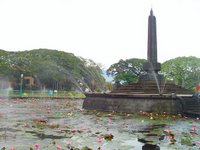 Malang, which is noted as one of the most beautiful, cleanest and coolest cities in East Java. Without any doubt, been famous since a long time ago and it became popular as a Dutch hill town in the late 19th century so many buildings are well preserved. The growth started after 1870, when the Europeans built coffee, rubber, and cacao plantations and the sugar industry of the government started to grow. The wealth attracted more and more Dutch. They built houses in the city, and holiday house in the mountains of Batu, Selekta and Lawang. Some major streets, like Jalan Ijen, are tree-lined European style boulevards. These thoroughfares retain their residential status and haven’t been destroyed by crass commercial development.
Malang, which is noted as one of the most beautiful, cleanest and coolest cities in East Java. Without any doubt, been famous since a long time ago and it became popular as a Dutch hill town in the late 19th century so many buildings are well preserved. The growth started after 1870, when the Europeans built coffee, rubber, and cacao plantations and the sugar industry of the government started to grow. The wealth attracted more and more Dutch. They built houses in the city, and holiday house in the mountains of Batu, Selekta and Lawang. Some major streets, like Jalan Ijen, are tree-lined European style boulevards. These thoroughfares retain their residential status and haven’t been destroyed by crass commercial development.The city is located on a nice, with vulcanoes surrounded plateau, 450 metres above the pressing heat of the lowlands. To the east is the Hindu’s sacred the active Gunung Semeru (Java’s highest peak at 3680 meters), and Bromo-Tengger. To the west is Gunung Kawi, which has mystical properties, particularly for the Chinese. To the north Gunung Anjasmoro, Arjuna and Penderman dominates the view, covered with hotels and holiday places. Batu, just 20 minutes higher, is even cooler and blooming. Its reputation as a city of flowers is well rooted.
Malang is also saturated in ancient history. This was the heart of the Singosari Kingdom. In the village of that name, 12 kilometers to the north are some extraordinary 700 years old monuments built to honour Hindu and Buddhist priests. All the numerous archaeological sites are close by and easy to visit by public transport.
Malang has a population of around 800,000 and a reputation for being an education city with several quality universities. So you’re bound to encounter students everywhere, and especially because, the cost of living is relatively lower than in other cities in Indonesia.
The native people of Malang are known to be religious, dynamic, hardworking, flexible and proud to be identified as an “Arema” (AREk MAlang = Youth from Malang). The original native comes from different ethnic backgrounds such as Javanese, Maduranese, and some even from Arab and Chinese descent.
The main language used is Bahasa Indonesia. But the natives commonly use Javanese language, using a mixture of Eastern Javanese and Maduranese dialect for daily conversation. The youth have developed a new dialect - typical of youth in Malang which they call “Boso Walikan” means pronouncing each word backward.
As where old Dutch planters and civil servants used to retire to a life of ease and comfortableness, Malang is my dream destination, one of the place where I can realize my retirement later on…
Source: Indahnesia and Malang Tourism

No comments:
Post a Comment